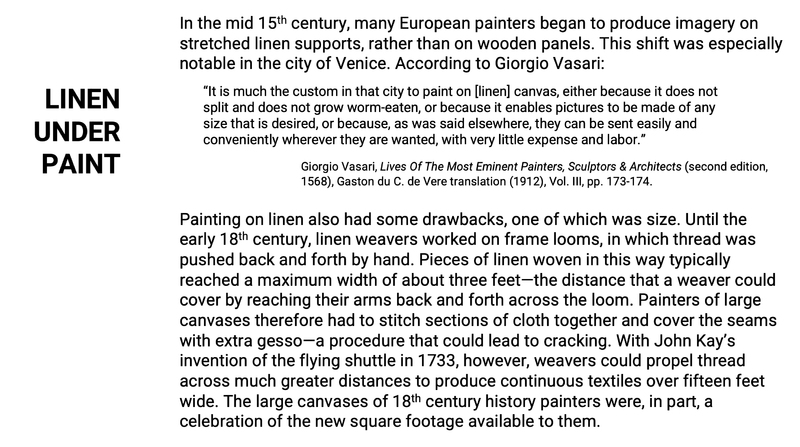Painting on linen
Item
Title
Painting on linen
In the mid 15th century, many European painters began to produce imagery on stretched linen supports, rather than on wooden panels. This shift was especially notable in the city of Venice. According to Giorgio Vasari:
"It is much the custom in that city to paint on [linen] canvas, either because it does not split and does not grow worm-eaten, or because it enables pictures to be made of any size that is desired, or because, as was said elsewhere, they can be sent easily and conveniently wherever they are wanted, with very little expense and labor.” --Giorgio Vasari, Lives Of The Most Eminent Painters, Sculptors & Architects (second edition, 1568), Gaston du C. de Vere translation (1912), Vol. III, pp. 173-174.
Painting on linen also had some drawbacks, one of which was size. Until the early 18th century, linen weavers worked on frame looms, in which thread was pushed back and forth by hand. Pieces of linen woven in this way typically reached a maximum width of about three feet—the distance that a weaver could cover by reaching their arms back and forth across the loom. Painters of large canvases therefore had to stitch sections of cloth together and cover the seams with extra gesso—a procedure that could lead to cracking. With John Kay’s invention of the flying shuttle in 1733, however, weavers could propel thread across much greater distances to produce continuous textiles over fifteen feet wide. The large canvases of 18th century history painters were, in part, a celebration of the new square footage available to them.
"It is much the custom in that city to paint on [linen] canvas, either because it does not split and does not grow worm-eaten, or because it enables pictures to be made of any size that is desired, or because, as was said elsewhere, they can be sent easily and conveniently wherever they are wanted, with very little expense and labor.” --Giorgio Vasari, Lives Of The Most Eminent Painters, Sculptors & Architects (second edition, 1568), Gaston du C. de Vere translation (1912), Vol. III, pp. 173-174.
Painting on linen also had some drawbacks, one of which was size. Until the early 18th century, linen weavers worked on frame looms, in which thread was pushed back and forth by hand. Pieces of linen woven in this way typically reached a maximum width of about three feet—the distance that a weaver could cover by reaching their arms back and forth across the loom. Painters of large canvases therefore had to stitch sections of cloth together and cover the seams with extra gesso—a procedure that could lead to cracking. With John Kay’s invention of the flying shuttle in 1733, however, weavers could propel thread across much greater distances to produce continuous textiles over fifteen feet wide. The large canvases of 18th century history painters were, in part, a celebration of the new square footage available to them.

